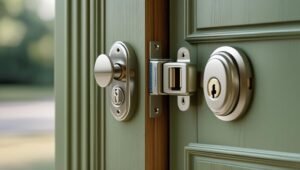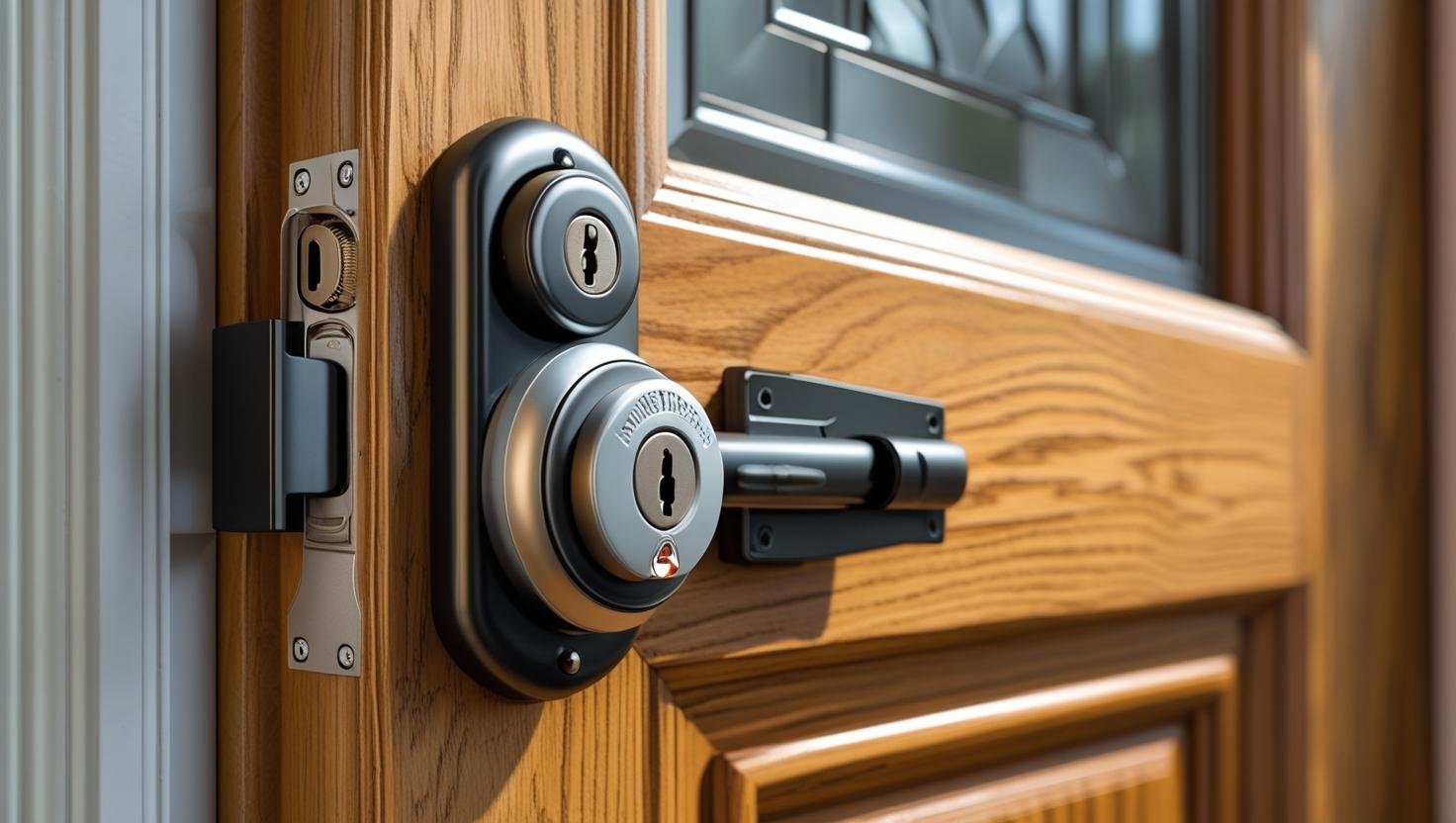Let’s be honest—when you’ve got a little one running (or crawling) around the house, your sense of security completely shifts. Suddenly, everyday things like the coffee table, electrical outlets, and yes, your exterior doors, turn into potential hazards. Most parents focus a lot of attention on baby gates and cabinet locks—and for good reason. But one area that often gets overlooked? The doors that lead outside.
Exterior doors can be risky. They’re a direct gateway to the unpredictable outside world, which includes everything from busy streets to backyard pools to stray animals. Childproofing these doors isn’t just a safety measure—it’s a necessity.
So if you’re wondering how to keep your adventurous toddler from wandering outside, or if you’re prepping your home for a new baby, you’re in the right place. In this guide, we’ll go through everything you need to know about how to childproof your exterior doors, step by step.
Types of Exterior Door Childproofing
Let’s take a look at some of the most effective childproofing methods out there and how they stack up.
| Childproofing Method | What It Does | Best For | Ease of Installation | Cost |
| Door knob covers | Prevents child from turning the knob | Round knobs | Very easy | Low |
| Top door locks | Locking mechanism installed at top of door | Tall doors with older toddlers | Moderate | Moderate |
| Sliding door locks | Prevents sliding doors from opening | Patio and balcony sliding doors | Easy | Low to moderate |
| Deadbolt covers | Prevents deadbolt manipulation | Any standard exterior door | Easy | Low |
| Security bars | Adds a physical barrier that stops door from opening | Back doors or secondary exits | Moderate | Moderate |
| Alarms and sensors | Alerts you when door is opened | All exterior doors | Easy to moderate | Moderate to high |
| Lever handle locks | Prevents pulling down on lever handles | Doors with horizontal/lever handles | Easy | Low |
| Smart locks | Allows remote locking and monitoring | Tech-savvy homes with toddlers | Moderate to hard | Higher |
| Door guardian systems | Combo of latch and brace to block door | High-risk doors like front entrance | Moderate | Moderate |
Practical Ways to Childproof Your Exterior Doors
Alright, now let’s break it down further. Here’s a detailed list of steps and tools you can use to make sure your child can’t easily get out through your exterior doors.
Install Door Knob Covers
These are one of the simplest tools in the childproofing arsenal. They go over your existing door knobs and require a squeeze-and-turn motion to open—something most toddlers can’t quite manage. Make sure they’re snug and can’t be pulled off easily.
Use a Top Door Lock
This is especially useful if your child is tall or particularly clever (you know the type). These locks are installed at the top of the door frame, way out of a child’s reach. They’re simple to slide into place and effectively prevent the door from opening, even if your child manages to turn the knob.

Secure Sliding Doors
Sliding glass doors can be a major point of concern. A basic latch lock might not be enough—kids can figure those out quickly. Instead, try a sliding door lock that attaches to the top frame, or even a security bar that physically blocks the track.
Install Door Alarms
Door alarms are underrated but incredibly effective. These small devices alert you with a chime or alarm whenever the door is opened. Some even come with smartphone connectivity so you can be notified when you’re not nearby. This is especially useful during nap time or if you’re working in another part of the house.
Get Lever Handle Locks
If your doors use lever handles instead of round knobs, it’s worth getting a lock specifically designed for those. Many toddlers quickly figure out how to pull down a lever, so a simple adhesive lock that prevents movement can save you a lot of worry.
Deadbolt Covers or Reinforcements
Some toddlers are surprisingly good at opening deadbolts if they can reach them. You can buy covers or reinforcements that either block access or make it more difficult to turn the lock. These are great for front doors that need to remain functional for adults but secure from curious little hands.
Add a Security Bar or Door Brace
These work well for back doors or less frequently used exits. A security bar is essentially a metal rod that rests against the floor or door frame, physically preventing the door from opening inward or outward. It’s a solid extra layer of security.
Install Smart Locks with App Controls
This option is a bit more high-tech, but very convenient. Smart locks can be operated remotely and programmed to lock automatically after a set period. Some even offer logs of when the door was opened and by whom. This is a more advanced solution but can offer peace of mind if you’re often away or have older children and visitors coming and going.
Use a Door Guardian
A door guardian is a type of latch that offers strong reinforcement and is mounted high on the door frame. It’s simple to install and very effective at keeping the door closed, even if the knob or deadbolt is unlocked.
Don’t Forget About the Screen Doors
While focusing on exterior doors, don’t overlook screen doors. They’re often much easier to open. Use a simple childproof latch or adhesive lock to keep them from being pushed open.
Adjust the Door Closers and Hinges
Sometimes kids can sneak out before a self-closing door shuts completely. Make sure your doors close firmly and that any hydraulic closers or spring hinges are working properly. You can also slow them down slightly to avoid slamming but still ensure closure.
Keep Keys and Remotes Out of Reach
If your child can find the spare keys or push a button on the remote garage door opener, you’ve got another issue. Keep keys, garage door openers, and smart lock remotes well out of reach and sight.
FAQs
Do I need to childproof all exterior doors?
Yes, ideally. Every door that leads outside poses a potential risk. Even if you think a door is rarely used, all it takes is one curious moment for a toddler to find it. Better safe than sorry.
At what age should I start childproofing?
You should start as soon as your child becomes mobile—crawling, cruising, or walking. That’s usually between 6 to 12 months. However, don’t wait until they’re opening doors—do it beforehand.
Are childproof door locks easy for adults to use?
Most are, yes. They’re designed with convenience in mind, so you can operate them easily with one hand in most cases. However, some models (especially those with strong spring mechanisms) may take a bit of getting used to.
Can I use the same lock for all types of doors?
Not always. The best lock or method depends on the type of door—whether it’s a swinging door, sliding glass door, or one with a lever handle. You might need a combination of solutions for different doors.
Will childproofing damage my doors?
Most modern childproofing tools are designed to be non-damaging and use adhesives or minimal hardware. However, stronger security tools like top locks or door braces might require screws. Always read the instructions and consider your door material before installation.
What if my child is tall or unusually clever?
Some kids are little escape artists. In that case, consider doubling up—use a knob cover and a top lock. Also, alarms or smart locks can give you real-time alerts. Don’t underestimate their creativity.
Childproofing your exterior doors might seem like a small thing on your long list of parenting to-dos, but it can make a world of difference. It’s not about turning your home into a fortress—it’s about creating a safe environment where your child can explore, play, and grow without you worrying every time you turn your back.
Whether you’re looking for a quick fix like a door knob cover or something more high-tech like a smart lock, the key is to stay a step ahead of your little adventurer. And remember, no system is foolproof—regular checks and updates as your child grows are just as important as the initial setup.
At the end of the day, childproofing is all about peace of mind. Knowing that your child can’t sneak out the door while you’re in the other room? That’s priceless.
So take a walk through your home, look at every exterior door through the eyes of a curious toddler, and start locking things down—literally.

